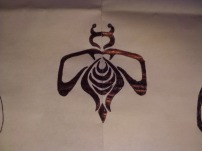Bee and Bear Ink
Bee and Bear Ink

Bee and Bear Ink is the creative idea of two very unique and artistic individuals, and it was from these two individuals that it got its name. Inspired by their own values and beliefs, and their love for each other, and motivated by the desire to express theses ideas. (Unfortunately, these two perfectly matched indivuals are no longer together but the dream WILL live on.) Having plenty of experience UNDER the needle, I have decided to jump behind the gun and offer other individuals an opportunity to experience to "joy" of getting a tattoo.
THE CHANGING CULTURAL STATUS
OF THE TATTOO ARTS IN AMERICA As Documented in Mainstream U.S. Reference
Works, Newspapers and Magazines
America's core cultural reference books, professional journals, newspapers and magazines recognize tattooing as a well-established art form that, over the last three decades, has undergone dramatic changes. In the 1970s, artists trained in traditional fine art disciplines began to embrace tattooing and brought with them entirely new sorts of sophisticated imagery and technique. Advances in electric needle machines and pigments provided them with new ranges of color, delicacy of detail and aesthetic possibilities. The physical nature of many local tattooing establishments also changed as increasing numbers of operators adopted equipment and procedures resembling those of medical clinics -- particularly in areas where tattooing is regulated by government health agencies.
The cultural status of tattooing has steadily evolved from that of an anti-social activity in the 1960s to that of a trendy fashion statement in the 1990s. First adopted and flaunted by influential rock stars like the Rolling Stones in the early 1970s, tattooing had, by the late 1980s, become accepted by ever broader segments of mainstream society. Today, tattoos are routinely seen on rock stars, professional sports figures, ice skating champions, fashion models, movie stars and other public figures who play a significant role in setting the culture's contemporary mores and behavior patterns.
During the last fifteen years, two distinct classes of tattoo business have emerged. The first is the "tattoo parlor" that glories in a sense of urban outlaw culture; advertises itself with garish exterior signage; offers "pictures-off-the-wall" assembly-line service; and often operates with less than optimum sanitary procedures.
The second is the "tattoo art studio" that most frequently features custom, fine art design; the ambiance of an upscale beauty salon; marketing campaigns aimed at middle- and upper middle-class professionals; and "by-appointment" services only. Today's fine art tattoo studio draws the same kind of clientele as a custom jewelry store, fashion boutique, or high-end antique shop.
The market demographics for tattoo services are now skewed heavily toward mainstream customers. Tattooing today is the sixth-fastest-growing retail business in the United States. The single fastest growing demographic group seeking tattoo services is, to the surprise of many, middle-class suburban women.
Tattooing is recognized by government agencies as both an art form and a profession and tattoo-related art work is the subject of museum, gallery and educational institution art shows across the United States.
OF THE TATTOO ARTS IN AMERICA As Documented in Mainstream U.S. Reference
Works, Newspapers and Magazines
America's core cultural reference books, professional journals, newspapers and magazines recognize tattooing as a well-established art form that, over the last three decades, has undergone dramatic changes. In the 1970s, artists trained in traditional fine art disciplines began to embrace tattooing and brought with them entirely new sorts of sophisticated imagery and technique. Advances in electric needle machines and pigments provided them with new ranges of color, delicacy of detail and aesthetic possibilities. The physical nature of many local tattooing establishments also changed as increasing numbers of operators adopted equipment and procedures resembling those of medical clinics -- particularly in areas where tattooing is regulated by government health agencies.
The cultural status of tattooing has steadily evolved from that of an anti-social activity in the 1960s to that of a trendy fashion statement in the 1990s. First adopted and flaunted by influential rock stars like the Rolling Stones in the early 1970s, tattooing had, by the late 1980s, become accepted by ever broader segments of mainstream society. Today, tattoos are routinely seen on rock stars, professional sports figures, ice skating champions, fashion models, movie stars and other public figures who play a significant role in setting the culture's contemporary mores and behavior patterns.
During the last fifteen years, two distinct classes of tattoo business have emerged. The first is the "tattoo parlor" that glories in a sense of urban outlaw culture; advertises itself with garish exterior signage; offers "pictures-off-the-wall" assembly-line service; and often operates with less than optimum sanitary procedures.
The second is the "tattoo art studio" that most frequently features custom, fine art design; the ambiance of an upscale beauty salon; marketing campaigns aimed at middle- and upper middle-class professionals; and "by-appointment" services only. Today's fine art tattoo studio draws the same kind of clientele as a custom jewelry store, fashion boutique, or high-end antique shop.
The market demographics for tattoo services are now skewed heavily toward mainstream customers. Tattooing today is the sixth-fastest-growing retail business in the United States. The single fastest growing demographic group seeking tattoo services is, to the surprise of many, middle-class suburban women.
Tattooing is recognized by government agencies as both an art form and a profession and tattoo-related art work is the subject of museum, gallery and educational institution art shows across the United States.
